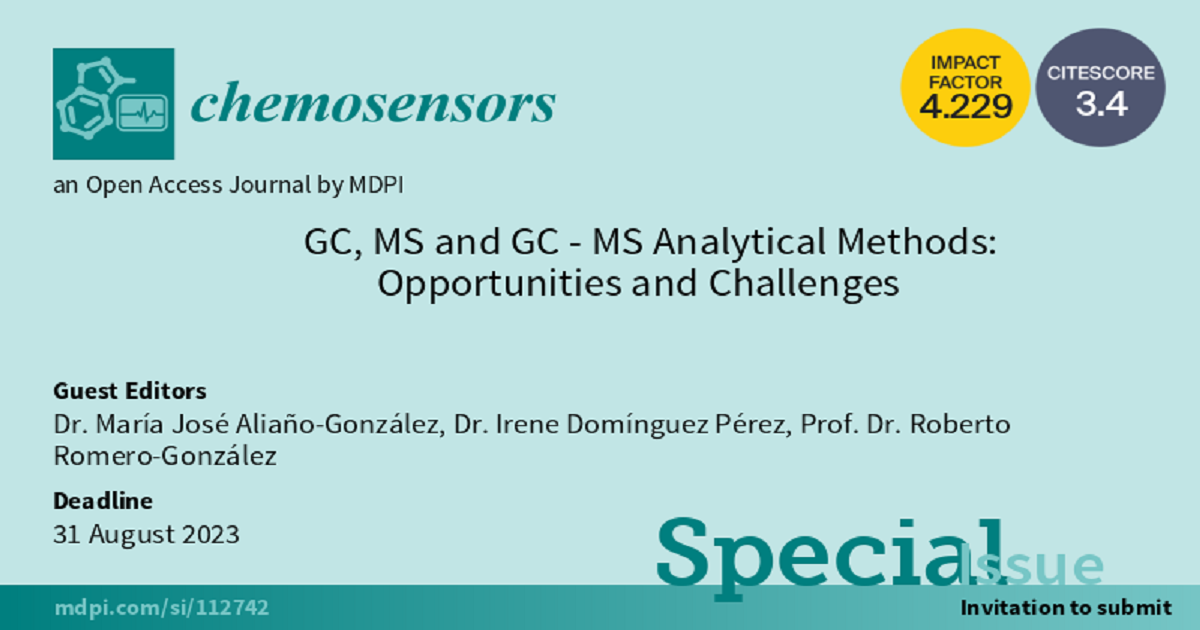GC, MS and GC-MS Analytical Methods: Opportunities and Challenges
A special issue of Chemosensors (ISSN 2227-9040). This special issue belongs to the section "Analytical Methods, Instrumentation and Miniaturization".
Deadline for manuscript submissions: closed (31 August 2023) | Viewed by 35244

Special Issue Editors
2. Mediterranean Institute for Agriculture, Environment and Development, University of Algarve, 8005-139 Faro, Portugal
Interests: agrifood resources; forensic chemistry; adulterations; fire analysis; environmental analysis; circular economy; bioactive compounds; chromatography; spectrophotometry; ion mobility spectrometry
Special Issues, Collections and Topics in MDPI journals
Interests: trace analysis; environmental pollution; food safety; bioactive compounds; food quality; sample preparation; chromatography; high resolution mass spectrometry
Interests: food safety; pesticides; analytical method development; chromatography; mass spectrometry; high-performance liquid chromatography
Special Issues, Collections and Topics in MDPI journals
Special Issue Information
Dear Colleagues,
Gas chromatography (GC) is an analytical technique that is used to separate volatile components from incredibly complex matrices (such as smoke, fuel spills, etc.) and those of an extremely varied nature for their subsequent identification and/or quantification. GC has also been coupled to multiple detectors, such as mass spectrometers (MS), which are significantly high-sensitivity (in the ppb range) devices for the analysis and exact identification of previously separated components. Recently, several researchers have applied MS as a chemosensor, a procedure in which each fragment ion (m/z ratio) acts as a sensor and its abundance is equivalent to the signal of the sensor, in order to elucidate the total characteristic profile of each sample, which is as unique as a fingerprint; this method allows an analytical problem to be resolved without the need to identify the compounds. This trend has also been observed among other GC-coupled detectors, such as ion mobility spectroscopy or even UV-Vis spectroscopy.
The Special Issue "GC, MS and GC-MS Analytical Methods: Opportunities and Challenges" aims to provide a forum for the latest research on the application of gas chromatography and/or mass spectrometry used as chemosensors for analytical purposes. Both review articles and research papers are welcome.
Dr. María José Aliaño-González
Dr. Irene Domínguez Pérez
Prof. Dr. Roberto Romero-González
Guest Editors
Manuscript Submission Information
Manuscripts should be submitted online at www.mdpi.com by registering and logging in to this website. Once you are registered, click here to go to the submission form. Manuscripts can be submitted until the deadline. All submissions that pass pre-check are peer-reviewed. Accepted papers will be published continuously in the journal (as soon as accepted) and will be listed together on the special issue website. Research articles, review articles as well as short communications are invited. For planned papers, a title and short abstract (about 100 words) can be sent to the Editorial Office for announcement on this website.
Submitted manuscripts should not have been published previously, nor be under consideration for publication elsewhere (except conference proceedings papers). All manuscripts are thoroughly refereed through a single-blind peer-review process. A guide for authors and other relevant information for submission of manuscripts is available on the Instructions for Authors page. Chemosensors is an international peer-reviewed open access monthly journal published by MDPI.
Please visit the Instructions for Authors page before submitting a manuscript. The Article Processing Charge (APC) for publication in this open access journal is 2700 CHF (Swiss Francs). Submitted papers should be well formatted and use good English. Authors may use MDPI's English editing service prior to publication or during author revisions.
Keywords
- gas chromatography
- mass spectrometry
- volatile compounds
- total profile
- chemosensors
- fingerprint
- analytical chemistry
- complex matrix







